 |

| |
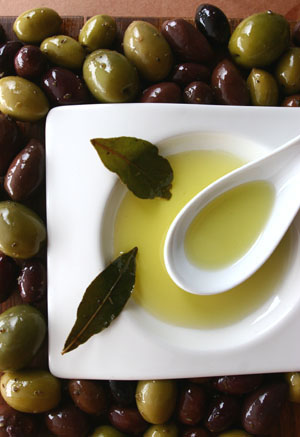
What’s more delicious than fresh, fruity olive oil? We can drink it right from the spoon—no bread dipping needed! Photography by B.A. Van Sise. |
| WHAT IT IS: Award-winning California artisan olive oils—unfiltered extra virgin and flavored oils—made from California olives grown without herbicides or pesticides. |
| WHY IT’S DIFFERENT: The flavored oils are made by crushing fresh fruit and herbs with the fresh-picked olives—not by infusing flavor into the pressed olive oil. It makes a big difference in flavor. |
| WHY WE LOVE IT: Vibrant, fresh tastes and personalities that stand out in the crowded field of artisan olive oil. |
| WHERE TO BUY IT: StellaCadente.com and specialty retailers nationwide. |
|
|
 |

Stella Cadente Olive Oils:
Shooting Stars
If there’s one specialty food we seem to be surrounded by, it’s extra virgin olive oil. No matter which way we turn, another bottle of viscous gold beckons. It would take a small phone book to list all of the contenders: Last year we tasted 100 extra virgin olive oils and only made a dent. Between the hundreds of cultivars (varietals) of olive, the worldwide growing regions where the same cultivar can produce oil with different flavor characteristics, and the blends, it’s as complicated as wine. You need an olive oil sommelier! Do you want a peppery oil with that dish, a fruity oil, an herbal, grassy, green oil? (Do you want to master the 60 or so descriptors of olive oil?)
We taste gallons of gourmet olive oil, looking for the ones that stand out in the crowd—the ones we’d plunk down $20 for without thinking twice, and give as gifts to people who appreciate the difference. When we tasted Stella Cadente olive oils from California (the name means “shooting star” in Italian), in a room of hundreds of brands of extra virgin olive oils, they sang to us. The olives are grown without pesticides, and hand-picked and stone pressed “the old fashioned way.” The result is a fruity, complex extra-virgin olive oil plus four flavored oils that are made by crushing the olives with the fresh fruit (blood orange, Meyer lemon, Persian lime) or herb (basil) at the mill. The flavors are more elegant than in products where flavor is infused after the oil is pressed. Dom Perignon, the first to taste Champagne, said that he was “drinking stars.” With these oils, you can drizzle some shooting stars that will make a lot of your cooking taste more celestial. Read the full review below.
|
THE NIBBLE does not sell the foods we review
or receive fees from manufacturers for recommending them.
Our recommendations are based purely on our opinion, after tasting thousands of products each year, that they represent the best in their respective categories. |
Learn More About Olive Oil
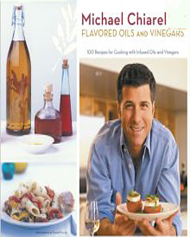 |
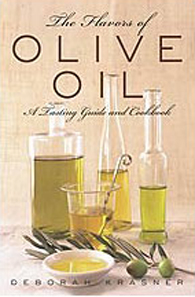 |
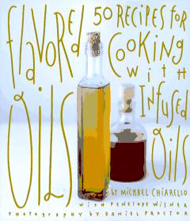 |
| Michael Chiarello’s Flavored Oils & Vinegars: 100 Recipes for Cooking With Infused Oils & Vinegars, by Michael Chiarello. The Food Network chef shares 100 creative recipes for both making and using flavored oils and vinegars that capture the essence of herbs, fruits, vegetables and spices. Sure to dazzle any dish. Click here for more information or to purchase. |
The Flavors of Olive Oil: A Tasting Guide and Cookbook, by Deborah Krasner. A comprehensive guide to tasting, understanding and cooking with extra virgin olive oil. Includes recipes that contain olive oil—appetizers, sandwiches and small dishes to salads, pizzas, entrées and even desserts. Click here for more information. |
Flavored Oils: 50 Recipes For Cooking With Infused Oils, by Michael Chiarello with Penelope Wisner. The owner/chef of Napa Valley’s Tra Vigne restaurant shares his wisdom for jazzing up ordinary dishes with flavored oils. His detailed advice on judicious use of them includes instructions for infusions that are easy-to-follow. Click here for more information or to purchase. |
Stella Cadente Olive Oils: Shooting Stars
INDEX OF REVIEW
RELATED ARTICLES
|
MORE TO DISCOVER
|
The Anderson Valley of Mendocino County, California is prime agricultural land that grows great Pinot Noir grapes, and has been compared to Tuscany for its rolling hills and natural beauty. There are few lights to brighten the night in the sparsely-populated county; the skies are dark, and in the summer, the display of shooting stars is spectacular. That’s how Stella Cadente got its name—it means “shooting star” in Italian. Under the shooting stars, on the Shooting Star Ranch,* the Stella Cadente Olive Oil Company tends its groves of more than 1,200 olive trees. Among the European cultivars are the classic Italians—Coratina, Frantoio, Leccino, Lucca, Maurino, Pendolino and San Felice. And there’s the American Mission olive, bred by Franciscan and Jesuit priests in California from cuttings carried to the New World from Spain. It got its name, like the Mission Fig and the Mission grape, because it was planted within the missions’ land holdings and used in both the secular life and religious practices of the mission.
*The Mission olives are grown on another estate in Butte County.
Each olive cultivar contributes something special—the Frantoio its fruitiness, the Leccino its sweet freshness, and so on. Stella Cadente blends carefully to achieve an Italian-style oil that’s fruity and peppery—though not so heavily peppered that it produces the “cough” beloved in Italy, but less so in the U.S. While more and more single-cultivar oils are coming onto the market, enabling olive oil lovers to understand and develop preferences for one type of oil over another, blended oil will always remain in style. Reasons include the olive tree’s natural tendency to bear fruit in alternate years and varying flavors of the fruit in any given year, depending on weather conditions and ripeness at harvest. Blending allows the producer to deliver a consistent “house style” year after year—the same strategy used to create nonvintage Champagne.
The company packages its oils in dark green glass bottles, imported from Italy. Like wine, olive oil is oxidized by light. Even if you keep your oils in a dark cupboard, like enchanted characters in fairy tales, you need to keep all rays of light away away from the precious liquid so that the enchantment remains. (Tips to safeguard all of your oils: Any oil will have a better shelf life if it is kept in dark glass in a dark place—ideally 65°F, which of course means don’t keep it in the cabinet next to your stove or in a cabinet on an outer wall where it gets seasonal heat. Second, all oils are best when fresh: Buy smaller sizes that you’ll use within six months. You can keep your oils in the refrigerator, but that can take up a lot of space, and you need to let the oil come to room temperature before you can use it. We top off our oils with a wine preserver spray each time we use them.)
Stella Cadente produces estate grown olives that are grown organically, without herbicides or pesticides. Most olives are picked by mechanical pickers for efficiency, but Stella Cadente’s olives are hand-picked to avoid bruising the delicate fruit—bruised fruit begins to degrade and ferment prior to pressing. Similarly, the best oil is made from just-picked fruit. Stella Cadente’s olives are rushed to the mill and are stone pressed within eight hours of picking, before the fruit begins to the fruit begins to decay, ferment and oxidize from the action of enzymes in the fruit itself (which is accelerated when the weather is too hot or too cold). Fermented olives produce the off-flavor known as “fusty,” the most commonly found negative flavor component in commercially produced oils. (Read about the other negative flavors—as well as the positive flavors and aromas of olive oil.) |
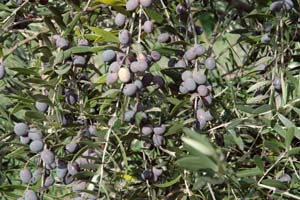
Pendolino o lives ripening on the branch at the Shooting Star Ranch (the cultivar is named for its pendulous, drooping branches). |
The oil is left unfiltered for maximum flavor. From the first release in 2000, domestic and international recognition rolled in for Stella Cadente’s extra virgin olive oil.
- In 2002 it was named Best California Extra Virgin Olive Oil by Slow Food, Italia.
- L’Autunno Extra Virgin Olive Oil† has won Best of Class and Best of Show at the Los Angeles County Fair’s Oils of the World Competition in 2003 and 2006, and L’Autunno Extra Virgin Olive Oil, Blood Orange Oil and Meyer Lemon Oil have been Gold Medal winners at the show.
- Der Feinschmecker, Europe’s largest gourmet magazine, named L’Autunno Extra Virgin Olive Oil one of the “Top 35 Oils of the World.”
- At the Yolo County Fair, Persian Lime Oil won Best of Show 2006 and 2007 in the Flavored Oils category; and the company’s newest release, Basil Oil, as well as L’Autunno Extra Virgin Oil received gold medals in their respective categories. (Yolo County, adjacent to Napa and Sacramento Counties in Northern California, is the home of the University of California at Davis, “U.C. Davis,” the premier school for America’s winemakers.)
†The company subsequently produced two different extra virgins, L’Autunno and Nuovo Olio.
According to Stella Cadente, the company has won more top awards than any other olive oil company in California. But it wasn’t all smooth sailing: At the beginning, wild pigs broke down the fencing and dug up three acres of newly-planted olive trees. Deer followed the pigs and feasted on the leaves. But the story shows, persevere and trees will grow and bear fruit that will become world-famous, award-winning olive oil.
Stella Cadente Olive Oil Varieties
The company produces two blended artisan extra virgin olive oils, L’Autunno and Olio Nuovo, plus four flavored olive oils—Basil, Blood Orange, Meyer Lemon and Persian Lime. The flavored oils are not infused; rather, the fruit or herb is crushed together with the olives at the oil mill, where the olive oil mixes with the fresh fruit juices or herb flavor. (In infusion, natural flavoring is added to the olive oil after it has been pressed). Crushed citrus oils make a lot of sense, because in addition to growing great olives, California also produces most of the nation’s citrus. Bring all that fresh fruit to the mill and start crushing! (Botanical note: The olive, though savory in taste, is not a vegetable but the fruit of the olive tree.)
Extra Virgin Olive Oils
L’Autunno Extra Virgin Olive Oil. A pale green oil with yellow tones, Stella Cadente’s L’Autunno Blend combines Coratina Frantoio, Leccino, Mission and Pendolino olives. Fruity on both the nose and palate, the lively, “new olive” flavor has nuances of herbs, mown hay and the flavor known in the olive oil world as tomato leaves—although few of us ever eat tomato leaves. There’s a long, peppery finish. L’Autunno is Italian for “autumn,” which is when the olives are harvested by the friends and family of Sue Ellery and Tom Hunter, founders of Stella Cadente.
Olio Nuovo. We didn’t taste this “new oil,” but it’s an early harvest of Coratina, Frantoio, Leccino and Pendolino olives, and it’s available on the website only. In the style of an Italian “green” (young, new) olive oil, it’s herbal, with the flavor of young fruit and peppery notes.
Flavored Oils
The flavored oils are produced by cold pressing (crushing) the fruit or herb directly with late-harvest Mission olives. These oils have a most beautiful texture, or mouthfeel—light and silky. The flavors are clean and clear, with both the olive and the fruit or herb showing distinctly. Because crushing provides a more delicate flavor than most infusions, the second flavor doesn’t overwhelm, but rather, provides a lilt (or a sprinkle of shooting stars) to whatever is prepared with them.
|
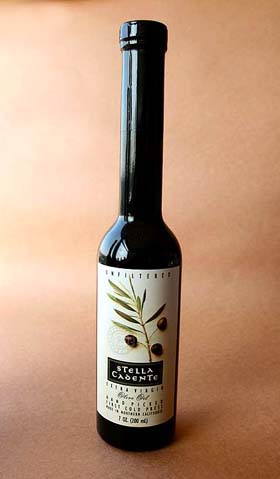
L’Autunno (“Autumn”) Extra Virgin Olive Oil was named one of the top 35 oils in the world, |
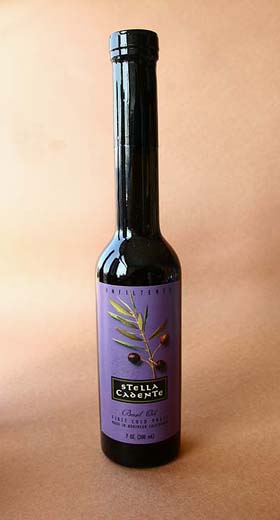
Basil Oil, the newest of the flavored oils, sold out quickly—which shows you how popular basil oil is. Mark your calendars to check the website at holiday time, and in the interim, enjoy the equally-delicious citrus oils.
|
Basil Oil. Basil Oil was introduced in January and promptly sold out. Happily, we were able to secure a bottle before the cache ran dry. The oil has a wonderful basil fragrance and a fresh basil flavor, with a gentle hint of pepper on the finish.
Serving Suggestions. A great dipping oil (bread, crudités), we drizzled Basil Oil on seafood, vegetables, lamb, poultry, in gazpacho and tomato soup. It’s easy—use it with any food you’d add fresh basil to. And then some:
- Try Basil Oil with figs or melon and prosciutto, or with smoked chicken and sundried tomatoes (a salad or sandwich).
- Use it on bruschetta, or to make a “mock” caprese salad when you have tomatoes and mozzarella, but no fresh basil.
- It’s delicious in a baked potato, instead of butter, and makes a lively potato salad instead of mayonnaise.
- It works with pasta, hot or cold. Use it as a lighter alternative pesto: You can make a simple but delicious pasta dish with basil oil, sundried tomatoes and a sprinkling of Parmesan (toss on pignoli nuts if you like).
- Try it instead of butter with corn on the cob.
Its sold-out status says to us that Americans are more familiar—and more comfortable cooking—with basil oil than citrus oil. If you aren’t including citrus oils in your repertoire, you’re missing out! |
Blood Orange Oil. Blood oranges are a special fruit—they just might be our favorite eating citrus. The pretty, deep rosy-colored flesh and berry flavors that meld into the traditional orange are a treat. The juice, like the flesh, is rosy in color (the skin is the same color as other oranges). A glass of blood orange juice is exquisite, and it makes incredible sorbet. To eat a good blood orange is a memorable experience; alas, we bought some Sunkist blood oranges in California recently that were memorably tasteless, although beautifully rosy-fleshed. (Try to buy from merchants who get their fruit from small growers.)
In decades past, we sought out blood oranges every time we went to Europe, until thankfully, the three main varieties were planted in California, and the fruit began to appear in our specialty produce stores. The Moro variety is considered the most reliable for color. Its fruit color can range from bright, raspberry red to dark purple. The basic orange flavor has berry-like overtones. The Sanguinelli has an oblong, egg shape, and isn’t found as often in markets. The color is not as deep as the Moro, but it has a delicious flavor and slightly less acidity. The Tarocco is considered by many to be the tastiest variety of blood oranges; however, it often has the least rosy color—sometimes only a slight blush or mottling in traditional orange flesh. People who have only bought the Tarocco may wonder what all the excitement is about, because they’ve never cut into a blood orange and found beautiful red flesh.
|
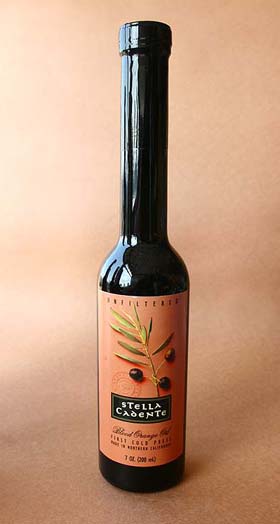
You can taste the juice in Stella Cadente’s Blood Orange Oil. |
You can taste the sweet juice in Stella Cadente’s Blood Orange Oil, which also has good peppery notes. This is pepper in the most positive sense—not one of those over-peppery, make-’em-cough oils that are so popular in Tuscany.
Serving Suggestions. Think of foods that can use orange accents—whether zest, fruit, liqueur (Grand Marnier, e.g.) or other types of orange flavor—and that’s where to begin with Blood Orange Oil.
- It will enhance any salad, but for a special salad, try beets with goat or Roquefort cheese and arugula; or an orange, watercress and endive salad, with or without the cheese.
- Drizzle it over grilled fish, shrimp or scallops, or roast poultry (it’s wonderful with duck) or pork. Use it to baste poultry, too.
- It can be used in any cake recipe calling for orange oil, and there’s an orange and ginger cake recipe on Stella Cadente’s website. We plan to substitute it for the plain extra virgin oil the next time we make an Italian olive oil cake (which, if you have never had the pleasure, is so buttery and delicious, you’d swear it was a butter cake—and it’s cholesterol-free).
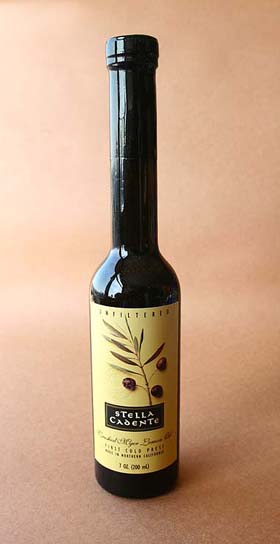
Meyer Lemon Oil is a new spin on an Italian tradition.
|
Meyer Lemon Oil. The Meyer lemon is less acidic, and therefore sweeter, than the Eureka, the large lemon grown in southern California that represents 80% of the U.S. lemon crop. Originally from China, the Meyer lemon is a cross with another citrus fruit, possibly the Mandarin orange. It is named after Frank Meyer, an explorer for the U.S. Agricultural Service, who brought it back in 1908. Until recently, the Meyer lemon was not well-known in the U.S. outside of sub-tropical growing regions like California, because it is thin-skinned, delicate and does not ship well enough to satisfy large commercial interests. However, growing demands for specialty fruit and produce (plus food service companies and consumers willing to pay more for special handling) have led to commercial production and distribution.
Traditionally, Italians celebrate the end of the olive pressing season by crushing lemons together with the late harvest olives. Meyer Lemon Oil is a lemony olive oil with a pleasant pepperiness that added graceful notes to everything we anointed with it.
Serving Suggestions. For people who are timid about trying citrus oils, Meyer Lemon Oil may be a good place to start. Of the three, lemon is perhaps the most common food seasoning, and Stella Cadente’s Meyer Lemon Oil has the subtlest fruit intensity among the three citrus oils.
|
- Meyer Lemon Oil pairs beautifully with any fish or seafood, poultry, vegetables and salads.
- Toss it with smoked salmon pasta salad, drizzle it on pork loin, use it to grill vegetables (or drizzle it on a grilled vegetable sandwich).
- La Brea Bakery in Los Angeles serves a sliced avocado and sprouts sandwich on a croissant, drizzled with Meyer Lemon Oil.
- Use it in baking. Try it in an Italian olive oil and fresh herb cake (rosemary, sage).
Persian Lime Oil. To us, Persian Lime Oil is the most seductive of the citrus flavors. The moment you pull the cork stopper from the bottle, the scent of fresh lime juice wafts up, as if someone has just squeezed a lime into the bottle. It tastes the same way: We drank this flavor from our tasting cup as if it were an olive oil Margarita (hold the salt). It’s smooth as silk. We poured it on Palazzolo’s Tahitian Vanilla Gelato to make a nouvelle lime “Creamsicle” (any vanilla ice cream will do), and on several citrus sorbets.
Before you think that Persian lime is something exotic, here’s a little lime lesson: It’s the same lime you see every day, grown in California and also known as the Tahitian lime and the Bearss lime. It is seedless (which means there are a few large seeds, as opposed to many small ones). The other lime variety that is generally available in the U.S. is the key lime or Mexican lime (also called the West Indian lime and the “bartender’s lime”), which is smaller, less acidic and more flavorful, with a pure lime flavor—and more seeds. Other limes that can be found in specialty markets are the Palestine sweet lime, (or simply, sweet lime), which has almost no acid, and the kaffir lime, which is used in Asian and Middle Eastern cuisine. When limes are fully ripe, by the way, they turn yellow and look like lemons; limes that are going to market are picked green, when they contain more acid. But, back to the star of the moment, Persian Lime Oil.
Serving Suggestions. We like this oil on absolutely everything, so see all of the serving suggestions above. Also try: |
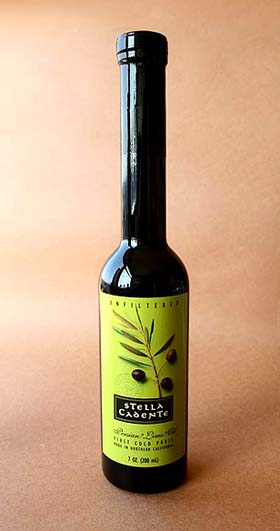
Our favorite of the flavored oils, Persian Lime, smells
and tastes as if a fresh lime was just squeezed into
the bottle. |
- Zesty lime vinaigrette (serve it with avocado, half or sliced, plain, with salad and/or fresh seafood).
- Fish and grilled seafood, especially salmon, tuna, scallops and shrimp.
- Mexican and Thai cooking (and other dishes typically served with a fresh lime wedge).
- Grilled vegetables and rice.
- Corn on the cob.
There are recipes for all of the oils on StellaCadente.com—pasta and rice, meats, soups and desserts. We’ve selected two light, summery ones below.
Recipes
Thai Salmon, Ginger and Lime Salad in Lettuce Wraps
Light, healthy and delicious, for lunch, a first course or snacks.
Ingredients
- 1 pound wild salmon fillet
- 2 teaspoons Stella Cadente L’Autunno Extra
virgin olive oil
- 3 tablespoons Stella Cadente Persian Lime Oil
- 5 small shallots, thinly sliced
- 2 tablespoons fresh ginger
- 1 small jalapeño, thinly sliced
- 2 tablespoons Thai fish sauce (nam
pla—available at Asian markets)
- 1 tablespoon honey
- 1 small cucumber, seeded and chopped
- 4 scallions, sliced
- 1/2 cup cashews, dry roasted & chopped
- Salt to taste
- Red pepper flakes (optional)
- 2 small heads of Bibb lettuce, washed and dried
- 1 small fresh pineapple, peeled and sliced
Directions |
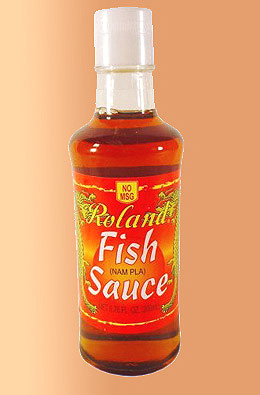
Nam Pla is called “fish sauce,” but is actually
anchovy sauce made by fermenting fresh anchovies in salt and water. It is an essential ingredient in Thai and Vietnamese cooking, used in soups, sauces and dressings to add flavor, and used as a table condiment instead of salt. |
- Chop salmon fillet into 1-inch chunks. In large nonstick skillet, heat olive oil. Stir fry shallots, ginger and jalapeño until softened, 2 minutes.
- Add the salmon. Stir just until it changes color on the outside—about 2 minutes.
- Add the fish sauce, Persian Lime Oil and honey. Cook until the liquids are thickened and the salmon is almost flaking. Place in a dish.
- Toss the cucumbers, scallions and cashews with pinch of salt in a small serving bowl. Place whole lettuce leaves on a plate. Serve with the salmon.
- Each person assembles his or her own wrap by spooning some salmon into a leaf, adding some cucumber mixture and rolling the leaf. Add pineapple slices. Serves 4.
Orange, Watercress, & Endive Salad With An Asian Orange Vinaigrette
This can be served as a luncheon salad or a side salad with the goat cheese, or without the goat cheese as a side salad. You can add your own touches, for example, by using blue cheese or sliced chicken, pork or duck instead of the goat cheese, and/or adding toasted pecans and dried cherries.
Ingredients
- 2 large Belgian endives, separated into leaves
- 4 large seedless oranges, peeled and sliced
into rounds
- 2 bunches watercress, woody stems
discarded and rinsed
- 2 cups cored, finely sliced radicchio
- Fresh sunflower or daikon sprouts (can
substitute bean sprouts)
- Optional: 8-ounce fresh goat cheese log (for
added flavor, try , like
Fig or Peppadew from Joan of Arc)
For the Asian Orange Vinaigrette
- ½ cup frozen orange juice concentrate
- Zest and juice of one large orange
- ¼ cup light soy sauce
- 1/3 cup rice wine vinegar
- 1 tablespoon peeled and minced fresh ginger
- 1-½ teaspoons toasted sesame oil
- 1/3 cup Stella Cadente Blood Orange Oil
- 2 tablespoons finely-chopped green onions
- 3 tablespoons finely-chopped cilantro or parsley
- Salt and freshly-ground pepper
|
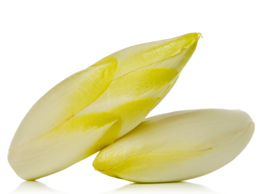
Belgian Endive
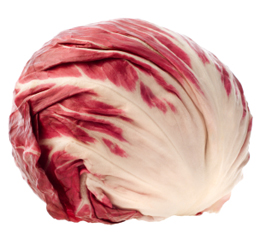
Radicchio |
Photo of endive by Arnaud Weisser | IST, photo of radicchio by YinYang | IST.
Directions
- Prepare the vinaigrette. Place the first 5 ingredients in a food processor or blender and process until smooth. Add the oils and pulse 2 or 3 times into a light emulsion. Whisk in onions and cilantro and season to taste with salt and pepper. Note: The vinaigrette can be made in advance and will keep up to 5 days, covered, in the refrigerator. It also makes an excellent marinade for grilled fish, chicken or pork.
- Make an attractive arrangement of the endive, orange and watercress on chilled plates. Toss the radicchio with a couple of tablespoons of the vinaigrette and mound it in the center of the plates. Cut the goat cheese in 1/4" slices and add 3 slices to each plate, evenly spaced around the perimeter. Drizzle additional vinaigrette over the salad, and top with sprouts.
- Serves 6 to 8. Recipe from John Ash, modified with Stella Cadente oil.
Buy all five bottles, read the recipes on the website, and you can guarantee yourself an energetic flavor festival for several months.
—Karen Hochman
FORWARD THIS NIBBLE to your favorite fine cooks, and to anyone who likes artisan olive oil.
STELLA CADENTE OLIVE OIL COMPANY
EXTRA VIRGIN OLIVE OILS: L’Autunno Blend, Olio Nuovo Blend
FLAVORED OLIVE OILS: Basil, Blood Orange, Meyer Lemon, Persian Lime
- Flavored Oils
Two 200 ml Bottles
$30
Two One-Pint Mason Jars
$38.94
Other sizes and gift crates available
BASIL SOLD OUT AS OF THIS WRITING
Check website for availability
- Olio Nuovo 2007
Two 200 ml Bottles
$40
Two One-Pint Mason Jars
$34.34
Other sizes and gift crates available
- Club Stella
2 Pints Of Olive Oil, EVOO And A Citrus,
Shipped 3 Times A Year
$90.00
Buy online at StellaCadente.com
or telephone 1.800.305.1288.
|
 |

From left: Basil, Meyer Lemon, Persian Lime, Blood Orange, L’Autunno Extra Virgin.
|
Also available at select specialty food stores nationwide.
Prices and product availability are verified at publication but are subject to change. Shipping is additional.
Back to Index
Read more about our favorite
oils and vinegars and related products:
|
Check Out These Other “Top Pick Of The Week” Oils:
|
Do you have friends who would enjoy THE NIBBLE?
Click here to send them an invitation for the Top Pick Of The Week newsletter. |
ABOUT THE NIBBLE. THE NIBBLE, Great Food Finds, is an online magazine plus newsletters about specialty foods and the gourmet life. It is the only consumer publication and website that focuses on reviewing the best specialty foods and beverages, in every category. The magazine also covers tabletop items, gourmet housewares, and other areas of interest to people who love fine food.
© Copyright 2004-2025 Lifestyle Direct, Inc. All rights
reserved. All information contained herein is subject to change at any time
without notice. All details must be directly confirmed with manufacturers, service
establishments and other third parties. The material in this e-zine may not
be reproduced, distributed, transmitted, cached, or otherwise used, except with
the prior written permission of Lifestyle Direct, Inc.
|
 |
|
 |


















